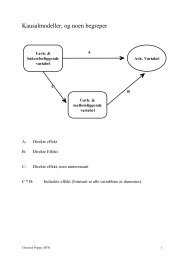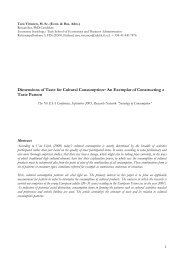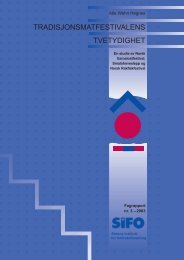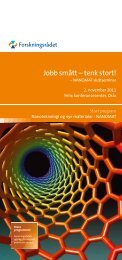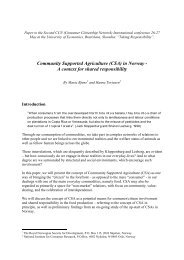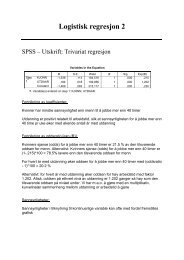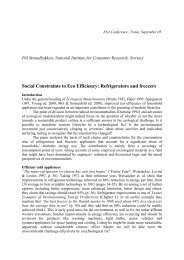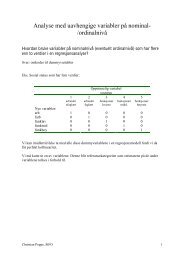an investigation of domestic laundry in europe - habits ... - SIFO
an investigation of domestic laundry in europe - habits ... - SIFO
an investigation of domestic laundry in europe - habits ... - SIFO
Create successful ePaper yourself
Turn your PDF publications into a flip-book with our unique Google optimized e-Paper software.
Hygiene effects <strong>of</strong> <strong>laundry</strong> processes <strong>in</strong> Europe 794.3.6 Wash<strong>in</strong>gThe wash<strong>in</strong>g mach<strong>in</strong>e is loaded with a gamma sterilised cotton base load. Thecomposition <strong>of</strong> the base load is <strong>in</strong> accord<strong>an</strong>ce with IEC 60456 [9]. The wash<strong>in</strong>gbags with <strong>laundry</strong> samples (a sample <strong>of</strong> each <strong>laundry</strong> item is put <strong>in</strong> a separatewash<strong>in</strong>g bag) <strong>an</strong>d the wash<strong>in</strong>g bag with the sterile samples are added tothe wash load. Direct contact between the wash<strong>in</strong>g bags is avoided. A perkilogram base load <strong>of</strong> 12.5 ml defibr<strong>in</strong>ated sheep blood (Biotrad<strong>in</strong>g) is addedto <strong>in</strong>crease the soil level. The load weight, wash<strong>in</strong>g programme, wash<strong>in</strong>g temperature,water hardness <strong>an</strong>d detergent used depend on the test.4.3.7 Enumeration <strong>an</strong>d confirmation <strong>of</strong> micro-org<strong>an</strong>ismsAll samples are directly removed from the mach<strong>in</strong>e <strong>an</strong>d put <strong>in</strong> a sterile stomacherbag at the end <strong>of</strong> the wash<strong>in</strong>g process. 50 ml <strong>of</strong> a buffered peptone solution(Oxoid, CM509) with a temperature <strong>of</strong> 30°C is then added. After 5 m<strong>in</strong>utes,the bag is stomachered for 30 seconds. The obta<strong>in</strong>ed solution is diluted<strong>in</strong> PFZ (Biotrad<strong>in</strong>g, K110B009) <strong>an</strong>d used for enumeration. The same procedureis used for the enumeration <strong>an</strong>d confirmation <strong>of</strong> micro-org<strong>an</strong>isms <strong>in</strong> thedirty <strong>laundry</strong> samples.Enumeration <strong>of</strong> Enterobacteriaceae1 ml <strong>of</strong> the serial dilution is tr<strong>an</strong>sferred to a plate <strong>an</strong>d mixed with ca. 10 mlViolet Red Bile Glucose Agar (VRBGA) (Lab M LAB88). After solidification<strong>of</strong> the agar, a topcoat is added us<strong>in</strong>g the same medium. The plates are<strong>in</strong>cubated for 20-24h at 37°C. Suspected Enterobacteriaceae colonies arecounted after the <strong>in</strong>cubation period. Confirmation is done by test<strong>in</strong>g the presence<strong>of</strong> oxidase (Bactidrop, Oxidase test R21540). Enterobacteriaceae arepurple colonies surrounded by a zone <strong>of</strong> purple precipitation <strong>an</strong>d are oxidasenegative.Enumeration <strong>of</strong> Staphylococcus aureus0.1ml <strong>of</strong> the serial dilution is spread on a Baird Parker (BP) plate (Biotrad<strong>in</strong>g,K002P090) <strong>an</strong>d <strong>in</strong>cubated for two days at 37°C. Black, sh<strong>in</strong>y colonies with ahalo were counted.Enumeration <strong>of</strong> Bacilli0.1ml <strong>of</strong> the serial dilution is spread on a MYP/PREP plate (Biotrad<strong>in</strong>g,K104P090) <strong>an</strong>d <strong>in</strong>cubated for one day at 30°C.




